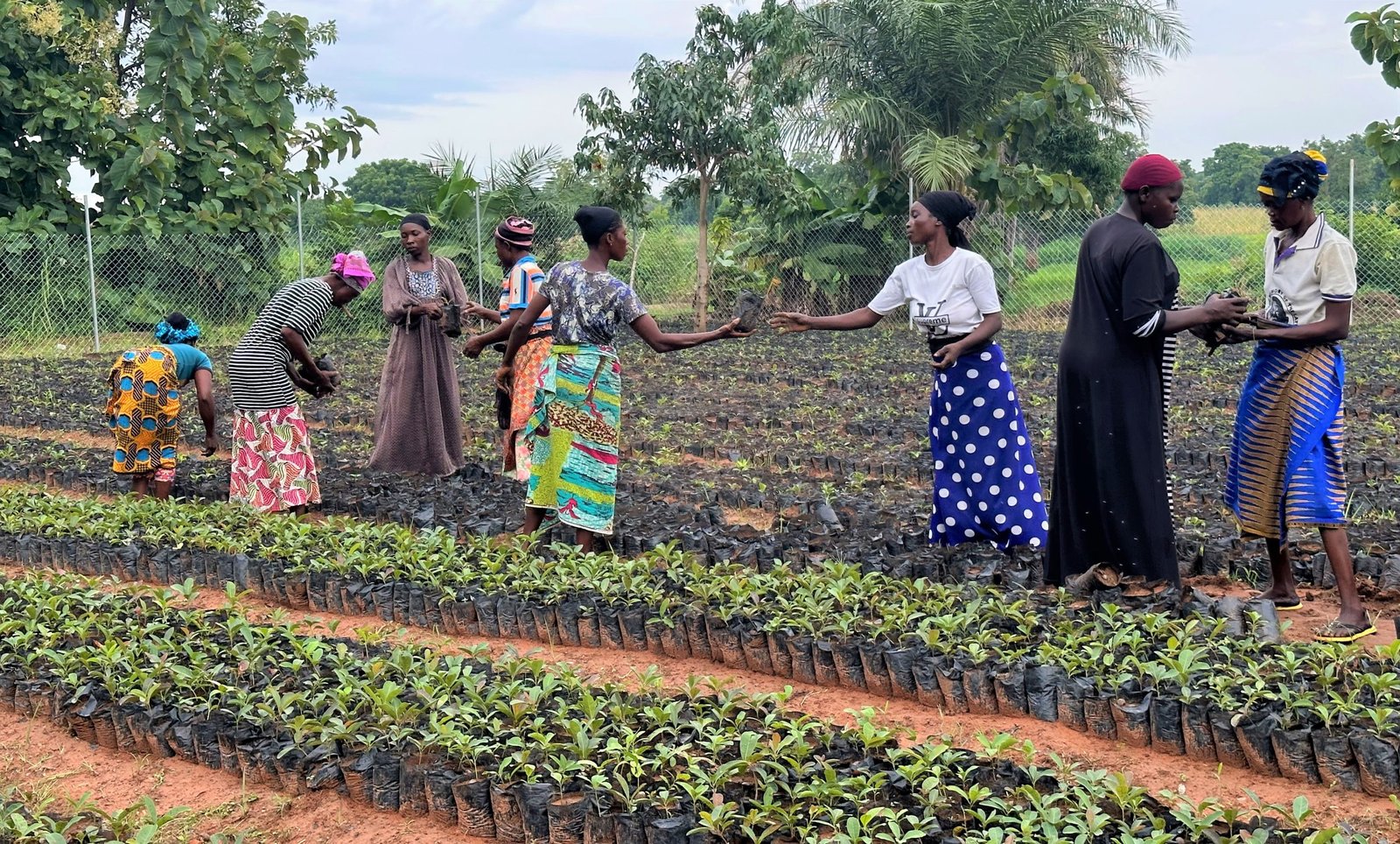Ghana’s shea industry generates employment and income for about a million rural women in northern Ghana. These women are mostly involved in gathering and processing shea fruits into butter. Many people across Ghana and beyond have developed strong taste for the shea butter as a great cosmetic. The shea trees usually grow naturally in traditional farms. These are integrated with crops on smallholder farms, creating an agroforestry landscape resilient to climate change.
However, the land in the savannah zone is facing a great threat with declining forest cover mostly due to conversion to agriculture, tree cutting for timber and wood fuels and bush fires. This poses a threat to the thriving shea business and endangers the livelihoods of many, especially women who heavily depend on it.
Briwana Nape is one of the oldest female farmers in the community of Achubunyo in the Central Gonja District of the Savannah Region of Ghana. She and her colleagues are making efforts to contribute to restoring the degraded lands. Her community is one of the 20 communities that have set up tree nurseries to plant shea and other native species like rosewood, tamarind, mahogany, dawadawa, African grapes, kapok, and baobab to restore the degraded shea parklands in the Northern Savannah Zone. For Briwana, the benefits from engaging in the restoration efforts is self-fulfilling.
“This initiative has brought a positive change, enabling me to generate extra income to cater for my family”, Briwana, who is also the women’s leader in the Achubunyo simply stated.
Encouraging Collective Actions for People and Planet
The nursery initiative falls under the Ghana Shea Landscape Emissions Reduction project, being implemented by the Forestry Commission (FC) of Ghana, in partnership with the United Nations Development Programme (UNDP), Global Shea Alliance and multiple national and local institutions, civil society organizations and private sector actors. The project is being supported by the Green Climate Fund (GCF).
“As we join the Forestry Commission and UNDP on this project, our goal is to further promote public private partnerships between the upstream shea value chain producers and the downstream private sector companies to co-invest in measures needed to ensure the future supplies of raw materials and sustain livelihoods within the shea landscape”, noted Mr. Aaron Adu, Managing Director, Global Shea Alliance.
Through the project, women like Briwana and other farmers are working to address the alarming deforestation and forest degradation challenges in the zone. These women and the communities will also benefit from the investments being made by private sector partners in the shea value chain. The project’s interventions are expected to reduce over 6 million tons of carbon emissions while improving the livelihoods of more than 500,000 people.
“I have joined my fellow women in this community to set up the tree nurseries. This initiative has not only brought in additional income but has also brought positive transformation in our lives, empowering us with newfound opportunities and possibilities”, stated Yakuba Ketiba, a farmer and a beneficiary of the tree nursery in Walewale in the West Mamprusi District of the North-East Region of Ghana.
Turning the Tide on Climate Change
Trees are essential for a healthier planet as they absorb carbon, provide oxygen, and support biodiversity conservation. It is therefore important to forge partnerships with different stakeholders including communities in climate action to restore degraded landscapes.
Nana Acheampong, popularly known as Zumanaa, is an old farmer and beneficiary of the forest restoration initiative in Kabampe in the Savannah Region of Ghana. He is working with both men and women in his community to restore degraded sections of the Kenikeni Forest Reserve, by integrating food crops with trees in his farm.
“I was given a 79-hectare land through the forest restoration initiative. I started planting food crops like yam, okro, pepper, and tomatoes, which do not only provide income but also feed my family at home. This opportunity has made a significant impact in our lives, ensuring a better future for my family”, Zumanaa narrated.
Zumanaa is practicing the Modified Taungya System (MTS) which is allowing him to integrate food crops with trees in the degraded forest and protecting the reserve with his family. The MTS has become a legally binding land lease arrangement in which farmers are considered co-owners of the plantations with the Forestry Commission. Apart from its environmental benefits, the MTS also serves as an additional income generation activity for the participating farmers.
“Our aim is to establish 25,500 hectares of forest plantations in severely degraded forest reserves and restore 200,000 hectares of off-reserve savanna forests. We are also working to restore 100,000 hectares of degraded shea parklands and remain committed to achieving these targets. We thank the communities for their great collaboration”, noted the Chief Executive of the Forestry Commission, Mr. John M. Allotey.
Fusing Innovation to Revitalize the Shea Tree
The value from the shea tree is indeed enormous. But the women have a worrying issue, and this has to do with the number of years the shea tree starts fruiting. The shea tree usually starts producing fruits after 15 to 20 years. To address this issue, the project is adopting grafting as a new innovative scientific approach to reduce the maturation period of the shea tree from 15-20 years in the wild to 5-7 years. In this regard, the farmers are being trained to adopt the grafting method.
Amishaw Alidu, one of the grafting training beneficiaries in the Lipga Community in the Northern Region of Ghana expressed excitement and is hopeful about the future.
“I have learnt how to graft a mature shea tree with a growing one and learnt that this would accelerate the fruition stage. I’m truly excited as this promises more early fruits and more income”, Alidu added.
The grafting innovation holds the potential to transform the shea industry and improve the livelihoods of those who depend on it. The project is aiming at grafting about 1.4 million shea seedlings, representing about 40% of the total shea seedlings, with an expected survival rate of about 70%.
The voices from the field testify to the positive impact that can be made for people and planet through collective actions.
“We are dedicated to achieving the objectives of this project. By restoring degraded forests and shea parklands, this project leads to reduced carbon emissions while expanding income generation opportunities along shea and agricultural value chains for women and men in the community. These inspiring stories from beneficiaries reveal the transformative potential of innovation matched with collective action”, noted Angela Lusigi, UNDP Resident Representative in Ghana.
It is evident that we can make much more positive impacts if partners and communities unite and co-create solutions to protect the planet and livelihoods. This intervention is a demonstration of the power of community involvement and public-private partnerships in the fight against climate change. More of these collaborations will definitely advance climate action and sustainable development.
Advertising and Press Release Distribution
For Advertising and Press Release Distribution or Publication in Ghana and across Africa, contact Africa Publicity and Production (AP&P) on +233543452542 or via email: africapublicityandproductions@gmail.com








